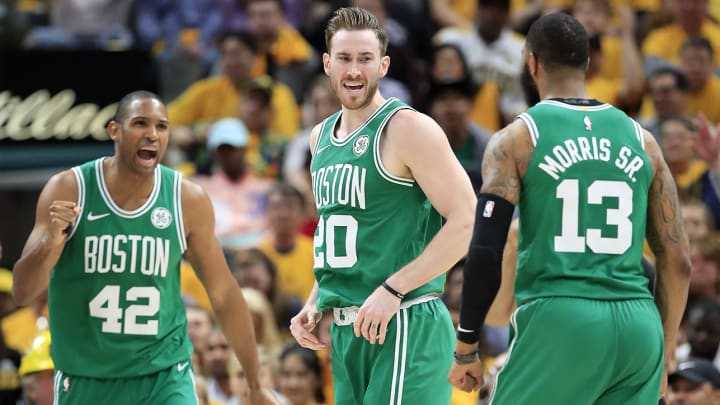Gordon Hayward Has Finally Found His Rhythm

BOSTON — Brad Stevens considered the question. It was late March, towards the end of a winding, twisting, unpredictable Celtics season and Stevens, from behind a desk inside his TD Garden office, was addressing a familiar topic: Gordon Hayward.
Hayward, who 19 months ago collapsed in pain on the floor in Cleveland, his leg broken, his ankle twisted backwards. Hayward, who seven months ago began the process of rebuilding his career as a shell of his former self. Hayward, who as Boston begins its second round series against Milwaukee this weekend has emerged as one of the Celtics most important players.
Stevens has been asked been asked every variation of questions about Hayward. When Hayward struggled—as he did in November, when he connected on 26.4% of his three’s, and December, when he made just 37% of his total shots—he was probed about his level of concern. When Hayward rounded into form—as he did in April, closing the season shooting 65% from the floor and 40% from three—it was what he thought about Hayward’s progress.
The Hayward that Stevens saw in November—tentative, sluggish, unwilling to engage—was what Stevens, what the Celtics, expected. The Hayward that has emerged in April—confident, more aggressive, driving towards contact rather than around it—is one Boston fervently believed would be there.
Said Stevens, “It’s almost exactly what I expected.”

If there has been a message the Celtics have drilled into Hayward since training camp, it’s this: You’re fine. Stevens knew Hayward was healthy. Physically, he could go full speed. Stevens never had a conversation with Hayward about getting his game back because, Stevens told The Crossover, “I didn’t want to insinuate that he couldn’t go out there and just have it.”
Scott Morrison felt the same. In 2017, Morrison, fresh off a head coaching stint with the Celtics G-League affiliate and beginning his first season on Stevens staff, was assigned to work with Hayward. After the injury, Morrison worked with Hayward on his recovery. When training camp opened last fall, Morrison worked to make Hayward believe he was recovered.
“I thought he had it,” Morrison told The Crossover. “I just thought he was afraid to use it.”
The rebuild of Hayward’s game has been well chronicled. Finding the right role, however, was equally challenging. Think about the basketball situations Hayward has found himself in over the last two years. He signed with Boston to co-star with Isaiah Thomas. At his first team press conference, he sat next to Kyrie Irving. He had been a full time starter since his fourth season; a month into this one, he was sent to the bench.
He has changed teams a handful of times, all while wearing the same uniform.
And yet—Hayward has found a rhythm. No one is quite sure when. Hayward says he started to feel good in December; Morrison pegs what he saw as a turning point shortly after New Year’s. A shift to the bench eased some of the pressure. A solid March turned into a terrific April. And when Boston needed to finish off Indiana in Game 4, there was Hayward, delivering 20 points, connecting on 78% of his shots, knocking down all three of his three’s.
“Physically, I feel way better now than I did at the beginning of the season,” Hayward said. “For sure, physically it’s been a slow progression. I’m still continuing to do my ankle exercises and try to strengthen that ankle but I think more than anything, having the experience, having the reps, getting the confidence back.”
Around the trade deadline, Celtics officials remarked that they didn’t need to make a deal—Hayward offered an in-house opportunity to improved that dwarfed any trade the team could make. Against Milwaukee, that could be the case. The Bucks have not seen this Hayward. In two games against the Bucks during the regular season, Hayward averaged 14.5 points. Respectable, though less so when you consider he did it while making 37.5% of his shots and 36.4% of his three’s. He missed Boston’s third meeting with Milwaukee, just after the All-Star break, after rolling his ankle working out during it.
The Celtics are a different team with this Hayward, and the Bucks know it.
This Hayward cuts hard and elevates at the rim. This Hayward creates contact. In Utah, Hayward was effective at drawing contact and getting to the line; in his last two seasons, he averaged six free throw attempts per game. This season, Hayward averaged 2.6 free throw attempts, the fewest since his rookie year. Towards the end of the season, there were flashes of the old Hayward. The six free throw attempts against Brooklyn. The 13 attempts against the Heat. In addition to getting Hayward comfortable creating contact, Morrison and Hayward have worked on different ways to do it. Getting his arms under defenders. Getting into a shot blockers body before he can jump. James Harden scored nearly ten of his NBA-leading 36.1 points from the free throw line this season. Hayward, Morrison says, could eventually have that kind of free throw-to-point ratio.
Boston is a trendy pick to knock off top seeded Milwaukee. But the Bucks—fresh off a 60-win season, with the likely MVP in Giannis Antetokounmpo and a collection of high level shooters around him—have plenty of reasons to feel confident. An effective Hayward won’t be a luxury. He will have to be an effective playmaker. “He’s the best on our team at making the right read with the ball,” Morrison said. He will have to continue to shoot at a high percentage. He will have to chase down shooters on a team that averages nearly 34 three-pointers per game.
He will have to be Gordon Hayward.
